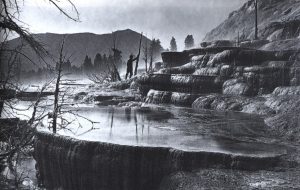Everything evolves with time, art and photography are no exception to that rule. With the advent of digital cameras, a clear distinction came between film cameras and those that use a simple plug-and-play memory card, but many people don’t realize that the differences go far beyond the convenience of no longer having to load up film.
For a photographer, that’s actually at the back of their mind. What really counts is the way the photos are processed and completed. That’s what affects the photo’s final presentation and, ultimately, how well the photographer is going to be able to let their own style shine through.
It could be said that early photographers were limited by their equipment. Not only were cameras huge, heavy, and very bulky, they were also very slow and difficult to work with. Not to mention that the end result was usually grainy and, of course, in black and white. Regardless, the best photographers were challenged to do there best, such as William Henry Jackson, a landscape photographer who was instrumental in convincing the United States Congress to turn Yellowstone into the first national park.
 It’s the work of early photographers like William Henry Jackson that inspire present day photographers to appreciate all the flexibilities we enjoy today. While William was limited by a hard-to-transport, slow to process, black-and-white camera, most of us today can pull a phone out of our pocket at a second’s notice and snap a beautiful full color photo in the blink of an eye.
It’s the work of early photographers like William Henry Jackson that inspire present day photographers to appreciate all the flexibilities we enjoy today. While William was limited by a hard-to-transport, slow to process, black-and-white camera, most of us today can pull a phone out of our pocket at a second’s notice and snap a beautiful full color photo in the blink of an eye.
For many, it would seem like a modern day photographer has an easier job than ever. After all, to the novice, it might even seem like today’s digital equipment does most the work for us. No more loading film, keeping it safe from the sun, or even processing it in a dark room. It’s as simple as powering on, snapping a shot, and looking at it instantly on the full color screen. At least, that’s what some think.
Innovation of Photography
In reality, photographers still have much to do in order to bring viewers shots that capture their subject in lifelike, stunning detail. Just about anyone can pull a smartphone out of their pocket and snap a photo and, while this sort of equipment does make it easier for everyone to dabble in photography, the professionals still must devote years of practice to master their framing, natural lighting, and even digital post-processing to make the end result as realistic as possible.
So, in short, as the equipment of photography continues to evolve, so must photographers. Now that equipment has eliminated the need for lugging around a huge setup all the time, photographers can continue to improve the art by spending more time focusing on the essentials of photo-taking, whether that be choosing the right scene or processing the picture so it looks as lifelike as possible when viewed by others.
All of these things are just in a day’s work for a professional photographer who is always trying to grow with the art form and help the art form grow to fit their changing needs.
